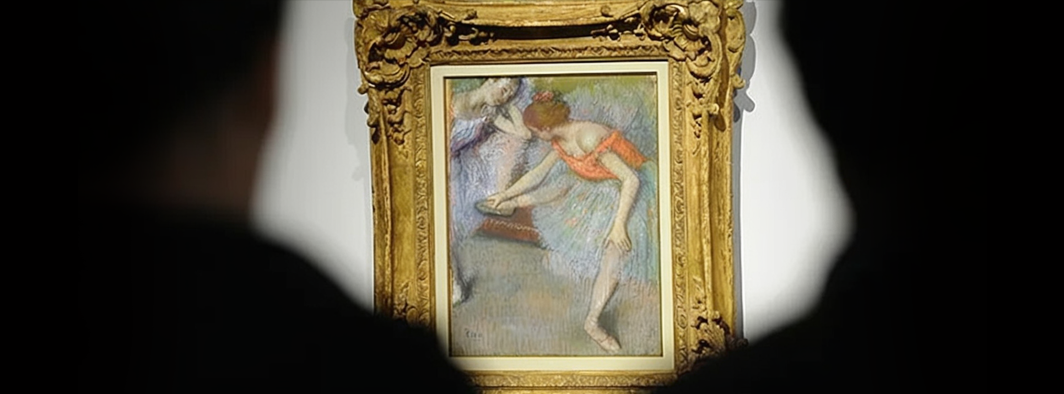The Sale of the Century: Part 2
We recently looked at the story behind one of the most incredible art sales in British history. The tale saw world-famous economist John Maynard Keynes, along with National Gallery director Sir Charles Holmes, travelling to Paris in 1918 – during the First World War – and bidding on the art collection of Edgar Degas, while the sound of German Artillery fired in the distance. If you haven’t yet read the details, you can find them in part one.
This is a story that seems like it could only happen once in a lifetime, or perhaps once in the history of the world. Keynes was such an unusual character, and the circumstances of the sale were so extraordinary, that the events could never come close to being replicated.
However, there are a surprising number of points that a contemporary art buyer can take away from this story, and the actions that Keynes took.
Developing Confidence
Throughout the story, Keynes seems to have taken all manner of risks, from convincing the government to approve such a massive sum for buying paintings during a war, to travelling to France himself. However, Keynes’ connection to the Bloomsbury group had enabled him to deepen and refine his knowledge and tastes in art, and he had experience in art investment. The confidence he displayed throughout the Parisian auction endeavour may appear to be taking a wild chance and winning out of sheer luck; but Keynes was not acting recklessly. He was not an economist playing the part of an art collector, he was an art collector. In fact, he added to his own collection at the auction as well.
Developing knowledge of the art world, as well as our own tastes as art collectors, can provide confidence when choosing artwork, even when it involves taking more of a risk.
Insider Tips
It was Keynes’ connection to the Bloomsbury Group that enabled him to take advantage of the Degas auction in the first place. His friend, the art critic Roger Fry, was the one who told him about the auction of artworks by artists such as Cezanne and Manet, whom Fry felt were underappreciated by the British art establishment, but would prove highly valuable in the future.
Cultivating a network of informed friends and professional connections in the art world, from artists to art dealers, can be of huge benefit to a collector. This can be the best way to get reliable tips about when to make a purchase, or indeed when you can get the best price for an artwork in your own collection.
Art as an Asset
Combining an expert understanding of economics and a deep love of art gave Keynes the edge when convincing the British Government to fund his adventure. Keynes understood the value of
art as an asset class when it came to investment. In his arguments to the Treasury, he brought up the fact that Britain had already loaned a considerable amount of money to France for the war effort – and that instead of making a further loan, they should spend the money on art. The money would still go to France, but the artworks purchased would appreciate in value, making this an incredible investment instead of a simple loan. And he was, as we now know, absolutely correct.
Optimistic Budgeting
Keynes knew that the £20,000 he had obtained from the government would be the capped budget for the National Gallery’s art purchases. Deciding ahead of time on your budget can certainly allow more freedom, and more confidence, when deciding which artwork to purchase. However, Keynes also knew that the size of the budget should match the size of the opportunity, and he didn’t hold back; the sum he took to the auction would be worth £955,000 today.
Admittedly, the budget was not coming out of Keynes’ personal coffers, and it is always easier to spend someone else’s money… however, he did not hesitate to dip into his own funds when he had the chance to purchase an original Cezanne for his own collection. The still life Pommes took its place in Keynes’ art collection when he returned home, among artworks by Braque, Seurat, Matisse, and Picasso.
Timing is Everything
Keynes and Holmes were already prepared to spend their considerable budget on the artworks at the auction, knowing that they would have to parse out the funds and compete with other bidders. However, when the German super-guns began firing at the start of the auction from just 80 miles away, many bidders left, leaving the remaining buyers with little contest as they snapped up artworks at incredibly low prices.
Knowing which artworks are worth buying is most of the battle; however, buying them at the best price is its own challenge. Often, by the time you know an artwork is valuable, it has already risen in value. The connections to the art market through your friends, or through tips from professional traders like Ezeldots, can help you make a move at just the right time. These moments can often come when you least expect them. A wartime auction is an extreme example, but challenging times can present once-in-a-lifetime opportunities to those ready to take advantage of them.
Your Art Collection
If you would like to learn more about the best time to sell an artwork from your own collection, get in touch with our team. You can also browse collectible artworks by some of today’s top art names in our listings, and perhaps find the artwork that you’ve been waiting for just the right time to buy…





